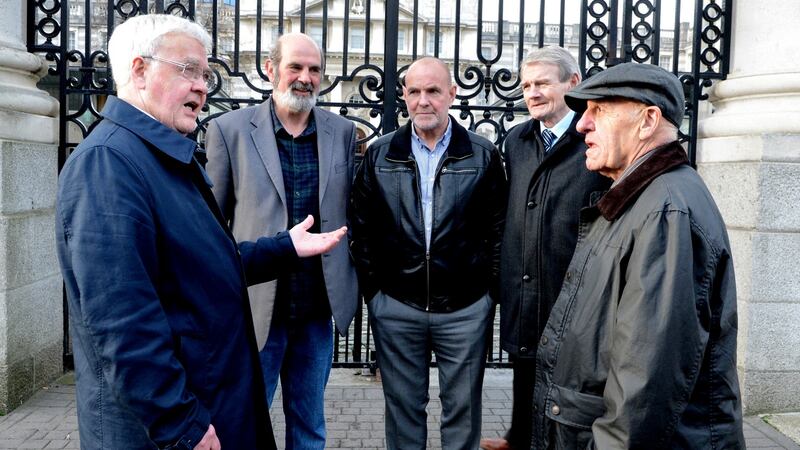The European Court of Human Rights has rejected the Government's case that fourteen men interned in Northern Ireland in the 1970s were subjected to torture.
The court ruled in 1978 the treatment of the so-called “hooded men” had amounted to inhuman and degrading treatment, but not torture.
A revised ruling in the case taken by Ireland against the UK was sought in 2014 on the basis of new information disclosed by RTÉ which the Government argued was not available to the court at the time of the original decision.
Ireland argued that new documents showed that the UK knew of the long-term effects the interrogation techniques used on the men would have.
However, in a ruling this morning the Strasbourg-based court that oversees the implementation of the European Convention of Human Rights, rejected the Government’s application for a revised decision.
It expressed doubt that the documents submitted supported the argument that a witness for the UK government had given misleading evidence as to the effect of the five interrogation techniques used on the fourteen men.
It also said that the evidence may not have had a “decisive influence” on the court’s original decision that the interrogation techniques constituted “a practice of inhuman and degrading treatment a breach of Article 3 of the European Convention on Human Rights” but did not constitute a practice of torture within the meaning of the provision.
“The court expresses doubts whether the documents submitted by the applicant Government in support of the first ground of revision contain sufficient prima facie evidence of the alleged new fact and considers that the documents submitted in support of the second ground did not demonstrate facts which were “unknown” to the Court when it delivered the original judgment.”

“Even assuming that the documents submitted in support of the first ground for revision demonstrate the fact alleged, namely that Dr L. misled the Commission as regards the effects of the five [interrogation] techniques, the court considers that it cannot be said that it might have had a decisive influence on the court’s finding in the original judgment that the use of the five techniques constituted a practice of inhuman and degrading treatment in breach of Article 3 of the Convention but did not constitute a practice of torture within the meaning of that provision.
“The applicant Government’s request for revision must therefore be dismissed,” the court said. It dismissed the request by six votes to one.
A dissenting opinion was issued by the Irish judge, Síofra O’Leary.
Major blow
The seven-judge Chamber also included a judge from the UK, Lord Reed, who agreed with the majority decision. A referral to the 17-judge Grand Chamber is possible. A request for such a move would be considered by a panel of the Grand Chamber.
The decision is a major blow to the surviving members of the group and their families of those who have since died. A press conference is due to be held in Belfast later this morning.
The five interrogation techniques used against by the men by the British army were prolonged standing against a wall, hooding, subjection to noise, deprivation of sleep, and deprivation of food and drink
An initial report on the case was issued by the European Commission of Human Rights in 1976 and found that the men had been tortured. The Commission was a body which dealt with cases before they went to the Strasbourg court. It issued reports,establishing the facts and expressing opinions, and could refer cases to the court.
Ireland asked for a referral to the Strasbourg court itself for a ruling. It was the first time a government took another government before the court.
The court came to a different conclusion than the Commission on the question of torture, finding that there had been inhuman and degrading treatment rather than torture. The Commission no longer exists.
Amnesty has said the 1978 finding has had disastrous consequences and has been used by the UK and the US to justify harsh interrogation techniques it operated.
In its original judgment the Strasbourg court said it appeared to have been the intention of the European Convention on Human Rights to attach a special stigma to “torture” and to distinguish between it and “inhuman or degrading treatment”.
“Torture” was understood to mean “deliberate inhuman treatment causing very serious and cruel suffering”.
The Strasbourg court has since made torture findings against Turkey (1996 and 1996), Russia and Ukraine (both 2011) and France (1999).
In the ruling against France the court said that as the Convention was a living instrument, treatment which had in the past been considered as “inhuman and degrading treatment” as opposed to “torture” could be classified differently in future.
It noted that an “increasingly high standard” in the area of the protection of human rights inevitably required “greater firmness in assessing breaches of the fundamental values of democratic societies”.











